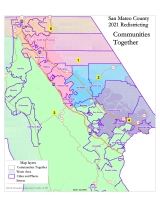Redwood City – The San Mateo County Board of Supervisors today voted unanimously to adopt the

“Communities Together” map that sets district lines for the next decade.
The 5-0 vote caps a months-long public outreach and engagement process. The Board, by state law, must adopt a new map that sets boundaries for each of the five supervisorial districts by Dec. 15, 2021, for use in the June 2022 primaries.
“This is truly a landmark occasion for everyone who cares about fair maps, who cares about ensuring that everyone has a seat at the table,” said David J. Canepa, president of the Board of Supervisors. “The Communities Together map establishes district boundaries that respect and empower our county’s diverse communities.”
San Mateo County Supervisor Don Horsley said, “Above all, I want to thank everyone who took the time and put in the effort to get involved and to give their input. Ensuring we have districts that minimize divisions and empower local communities is the very essence of representative democracy.”
The Board’s task was to create five districts that reflect changes in population based on the 2020 federal Census. This means each district must include roughly 153,083 residents, so that each person has equal representation. The location of district lines determines which voters can vote for which candidate.
The population target must be met while abiding by state and federal laws, including the Voting Rights Act, a landmark federal law that prohibits racial discrimination (gerrymandering, for instance) in voting.
The following shows the population in the approved map:
Communities Together: Total Population
| District | 1 | 2 | 3 | 4 | 5 | Total |
|---|---|---|---|---|---|---|
| Total Pop. | 147,541 | 158,4809 | 153,827 | 153,790 | 151,779 | 765,417 |
| Deviation from ideal | -5,542 | 5,397 | 744 | 707 | -1,304 | 10,939 |
| Each of the five districts must contain abouot 153,083 people. |
Two of the five new districts, District 1 and District 5, have voting age populations that are majority-minority, meaning the majority of eligible voters are racial or ethnic minorities. Specifically, District 1 is 58 percent majority-minority and District 5 is 80 percent majority-minority. In addition, Districts 2 and 4 have roughly equal voting age populations of minority and non-Hispanic white residents.
“Four of the five districts provide significant opportunities for traditionally under-represented groups to elect candidates that reflect the values of their communities,” Canepa said. “This is a significant achievement in drawing lines that respect the makeup of our communities today.”
The following shows the citizen voting age population in the approved map:
Communities Together: Citizen Voting Age Population
| District | 1 | 2 | 3 | 4 | 5 | Total |
|---|---|---|---|---|---|---|
| Total | 99,909 | 96,306 | 111,071 | 87,214 | 106,347 | 500,848 |
| % Hispanic | 21% | 14% | 10% | 28% | 18% | 18% |
| % Non-Hispanic White | 42% | 52% | 72% | 50% | 20% | 47% |
| % Non-Hispanic Black | 2% | 3% | 2% | 6% | 4% | 3% |
| % Asian/Pacific Islander | 35% | 30% | 15% | 15% | 57% | 31% |
Horsley said the new districts also respect the geographical integrity of local communities and neighborhoods with shared interests, known as “communities of interest.” The new map, for instance, minimizes the division of coastal communities and those living in East Palo Alto, Belle Haven, North Fair Oaks, and Redwood City.
Background
While the five districts must be substantially balanced in population, requirements also include compliance with federal and state equal voting rights and the following rank-ordered state law criteria:
► Drawing districts that are, as much as possible, geographically contiguous
► Keeping communities of interest intact, as much as possible
► Keeping cities intact, as much as possible
► Having easily identifiable boundaries (major highways, railways, streets, rivers, mountains), as much as possible
► Drawing districts to encourage geographical compactness, as much as possible.
To assist in the redistricting process, the Board earlier this year appointed an advisory commission, called the 2021 Supervisorial District Lines Advisory Commission, whose 15 members were recommended by members from local chapters of the League of Women Voters.
Although federal Census data was delayed, the Commission launched into a series of 10 public meetings to receive public testimony, discuss communities of interest and review draft maps. The Commission ultimately voted on Oct. 28. 2021, to recommend two maps to the Board of Supervisors on a vote of 8-7.
The Board, at a public meeting on Nov. 16, 2021, directed staff to return on December 7, 2021 with an ordinance adopting the “Communities Together” map. This map “best meets federal and state law requirements, including, to the extent practicable, respecting the geographical integrity of any local neighborhood or local community of interest,” according to the accompanying staff report.
The Board today approved an ordinance adopting the map, a move that must come back before the Board for a second reading on Dec. 14, 2021.
While the new map will determine lines for the next decade, four of the five current members of the Board of Supervisors are prohibited from running for re-election due to term limits.